Colca Canyon ( Cañon del Colca in Spanish) is the world’s second deepest canyon, famous for its beautiful terraced hillsides and flying condors. But you have only half-experienced the highlights of this region in Peru if you don’t plan a Colca Canyon trek.
The trails in Colca may not pass as many stone ruins as the Inca Trail to Machu Picchu, but the region makes up for it with stunning scenery and natural hot springs. In general, the further you walk, the fewer people you’ll share the trails within and around Colca Canyon.
Choose your base in Cabanaconde, a town on the canyon rim, and depart on one of the trails leading down into Colca Canyon. Alternatively, the town of Chivay in the upper Colca Valley is a convenient spot to plan day hikes to Andean villages surrounded by terraced hillsides.
The town of Cabanaconde is only 8 mi (13 km) past the iconic Colca Canyon condor viewing platform, or Mirador Cruz del Condor, and a must-visit spot for trekkers. In Cabanaconde, you can take walking trails that connect villages and natural attractions in Colca Canyon.
Colca Canyon is not just one defined trekking loop or path, unlike other treks in Peru . The map below indicates popular trail routes (in black) connecting villages within the canyon. There are several treks to choose from, and below are a few two and three-day options. Longer routes take you to further spots such as Huaruro waterfall and Tapay village.
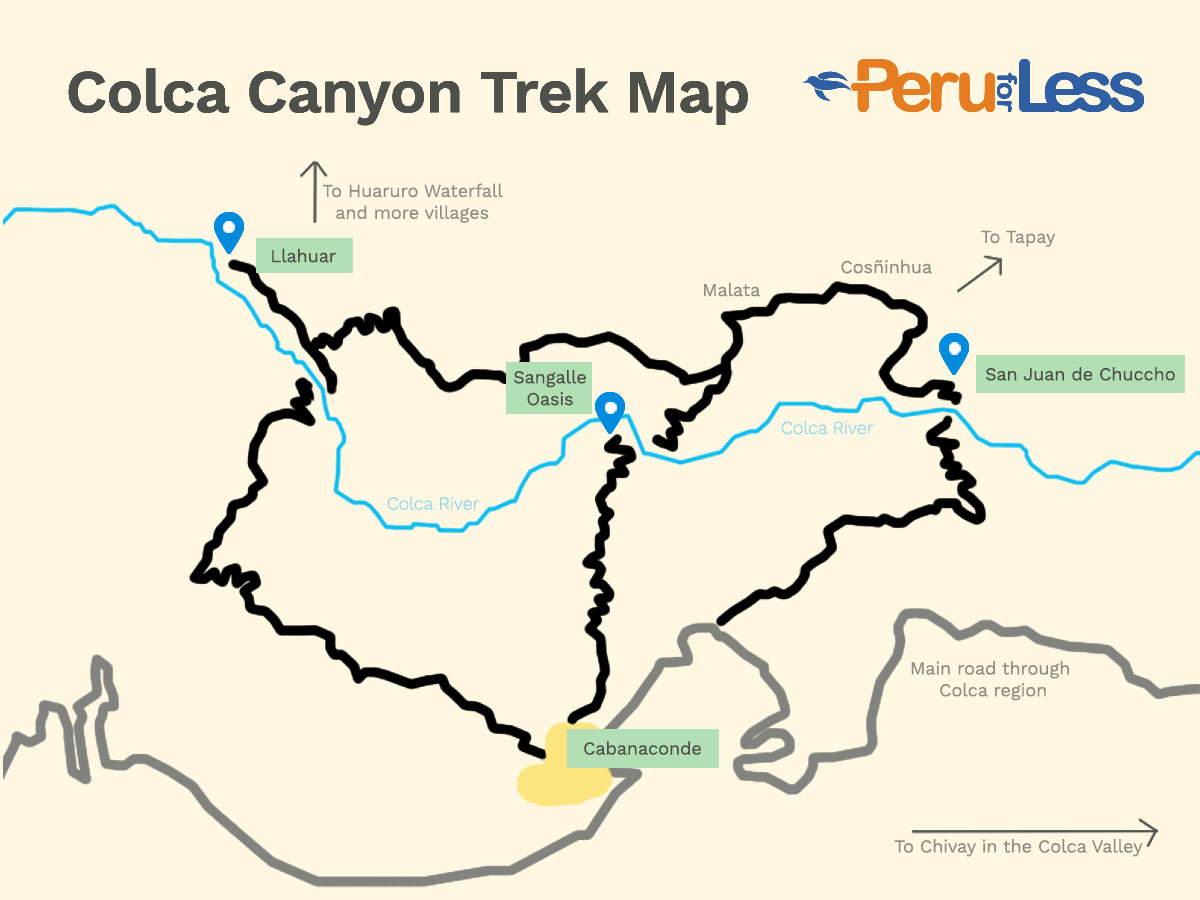
Colca Canyon Trek Map by Peru For Less
Recommended if you are short on time but would still like to trek into the canyon
Route: Cabanaconde > Sangalle Oasis > Cabanaconde
Overnight: Sangalle
Distance: about 5 mi (8 km) roundtrip
The well-trodden trail to the oasis known as Sangalle is a very popular Colca Canyon 2 day trek. Basic bungalows, campgrounds, and even pools for swimming make Sangalle a comfortable and popular village to spend the night. Plus, if you are trekking without a guide, there are places to buy cooked meals and extra water.
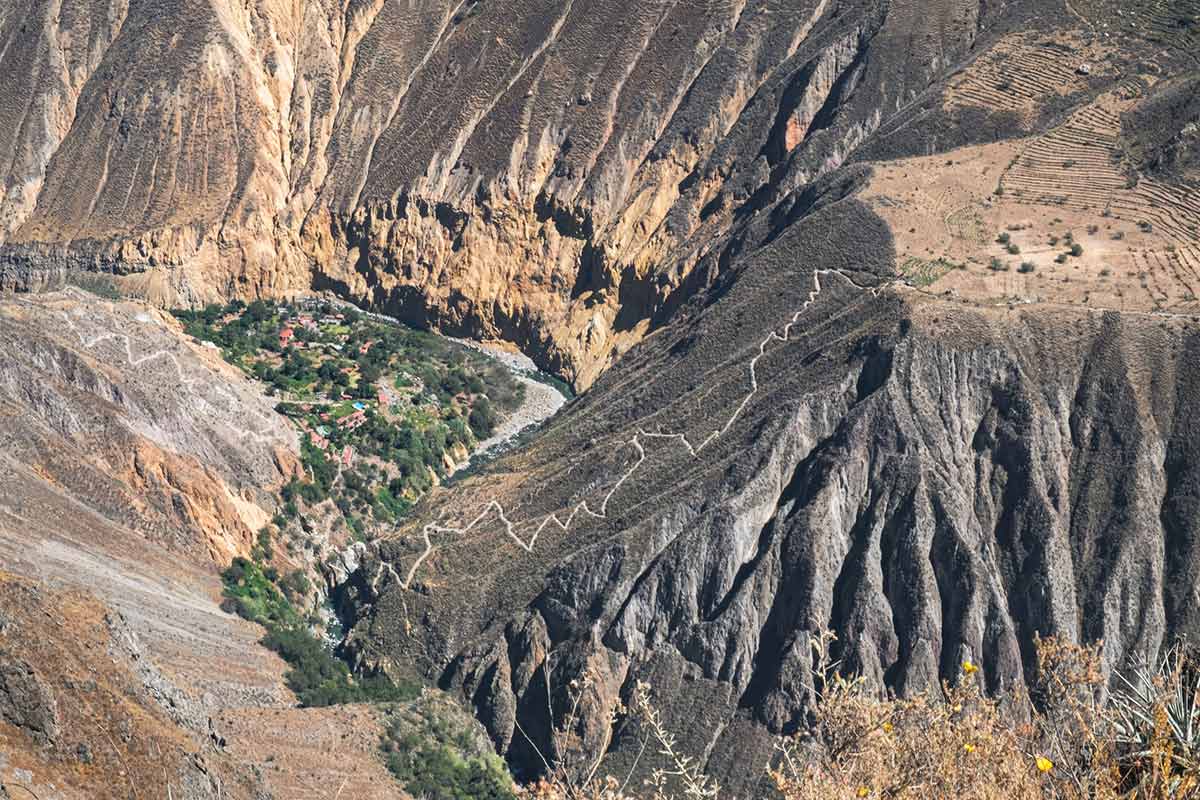
Escape to the canyon oasis of Sangalle. Photo by Sander Lenaerts on Unsplash .
Reaching the oasis takes about two hours descending on foot while ascending the steep trail back to the canyon rim can take anywhere from two to three hours (or more depending on your level of fitness and acclimation).
The down-and-up loop into the canyon from Cabanaconde is usually split up
with a night in Sangalle, but it’s possible to do it in one day. However,
there is a good chance you’ll remember more about being exhausted than being
amazed by the canyon scenery if you do it in only one day.
Recommended for an extended stay in Colca Canyon
Route:
Cabanaconde > San Juan de Chuccho > Sangalle Oasis > Cabanaconde
Overnight: San Juan de Chuccho (night 1), Sangalle (night 2)
Distance: about 12 mi (20 km) total
Set out on a trekking loop into the eastern part of Colca Canyon and spend the night in the villages of San Juan de Chuccho and Sangalle. Averaging between four to five hours of walking each day, this three-day trip isn’t too strenuous if you walk at a steady pace.
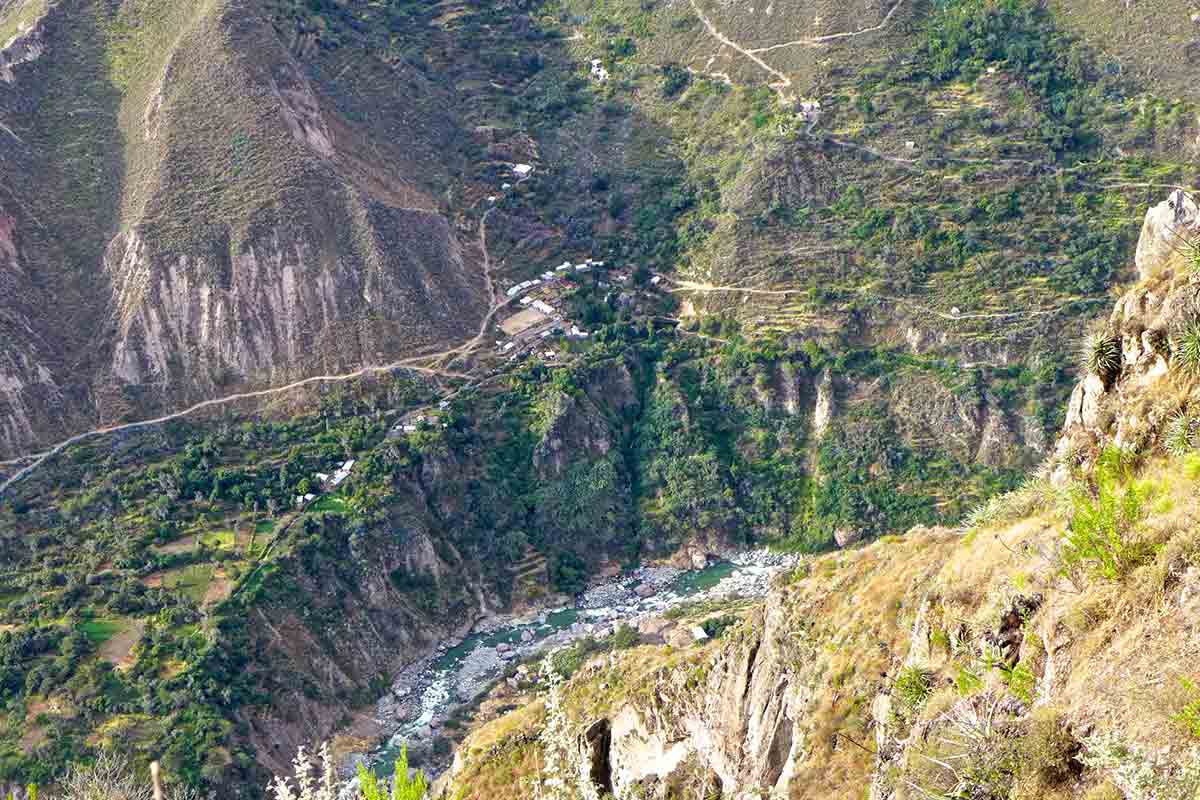
The village San Juan de Chuccho from high across the river. Photo (modified for size) by Monty VanderBilt/Flickr .
From the trailhead, not far outside Cabanaconde, the trail begins fairly even and transitions to switchbacks along the steeper descent to the canyon floor. The small village of San Juan de Chuccho sits along the Colca River and is not accessible by car. Guesthouse accommodations are limited and minimalist, but usually include a bed (dorm or private) and meals.
The next day, continue onwards to Sangalle. Pass through the village of Cosñirhua along the way and buy extra water and snack foods (fruit, chips, etc). The sparse vegetation on the trail transitions to greener vegetation and palm trees the closer you get to the Sangalle oasis for the second night.
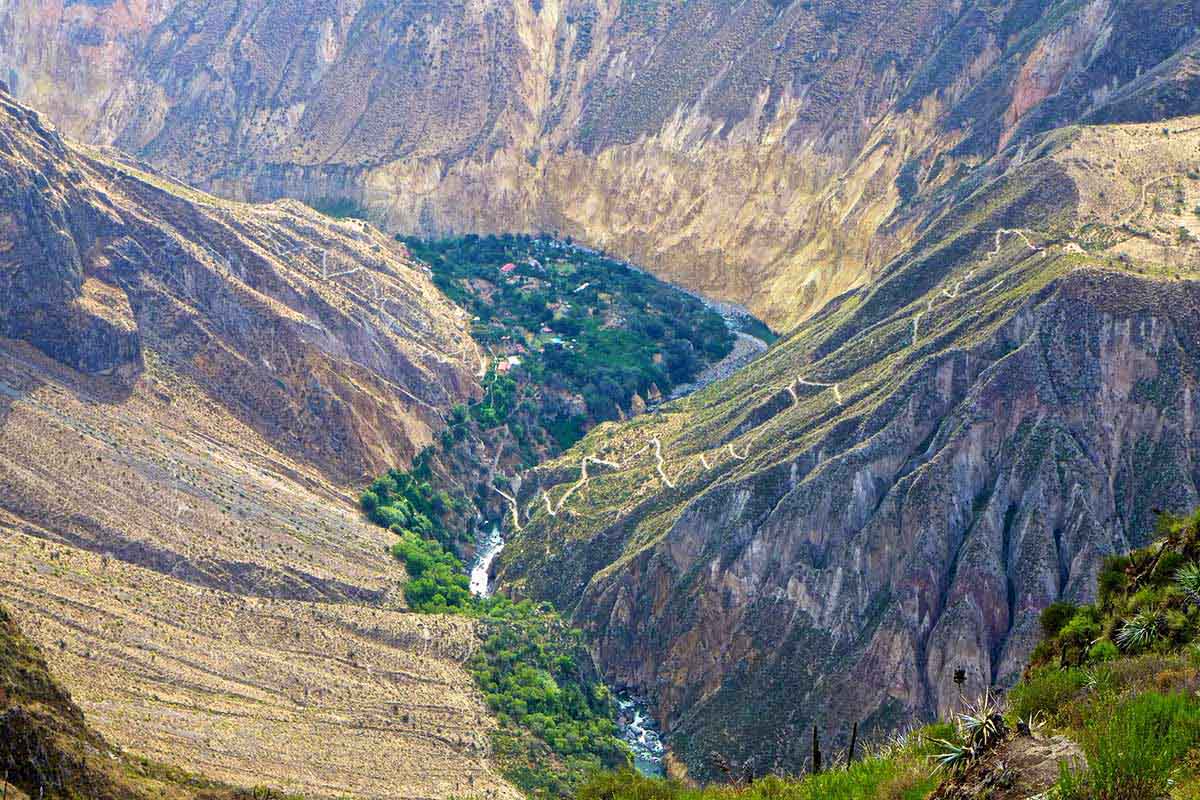
Save your energy for the steep climb out of the canyon on the third and final day of the trek. Mules are available to hire if you need help and are included with some guided tours.
Recommended if you are in good shape
Route:
Cabanaconde > Llahuar > San Juan de Chuccho > Cabanaconde
Overnight: Llahuar (night 1), San Juan de Chuccho (night 2)
Distance: about 19 mi (30 km)
This trekking loop takes you into the canyon to the village of Llahuar in the west to San Juan de Chuccho in the east. Sangalle is not part of this itinerary, allowing you to bypass the crowds and party-goers that sometimes occupy the oasis.
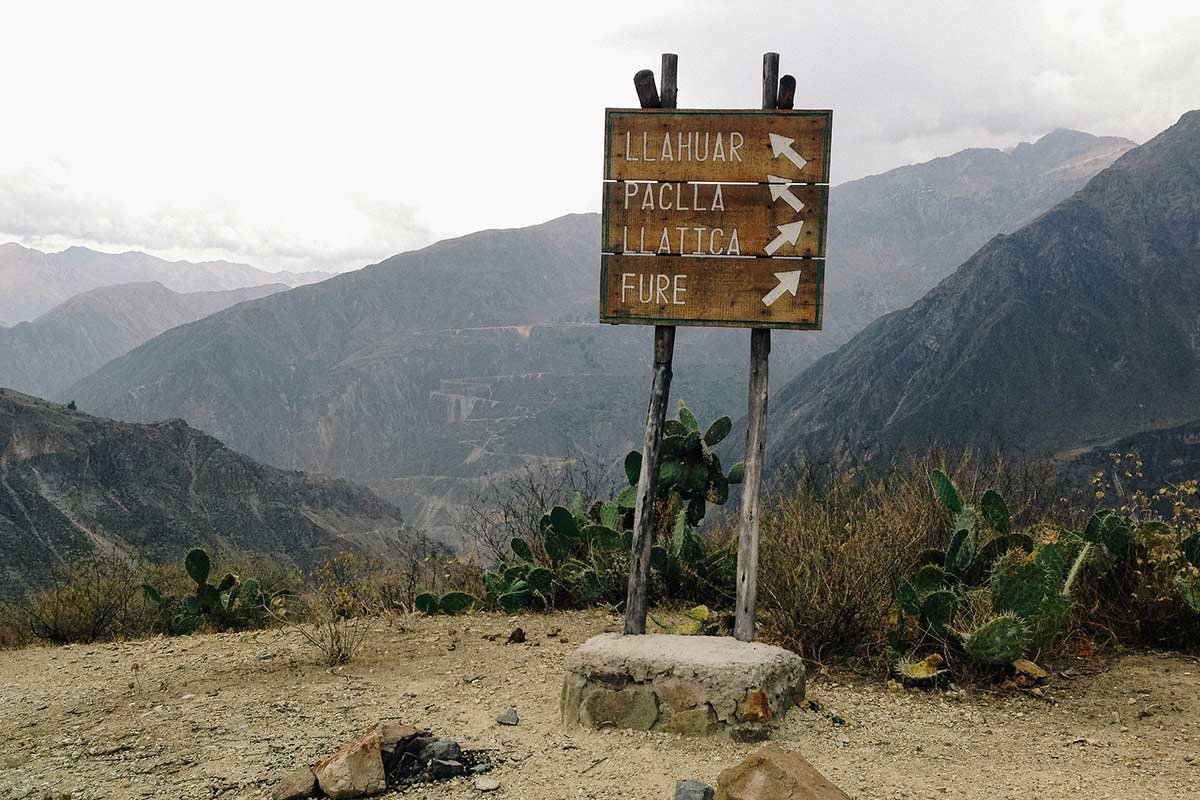
All trails go to beauty in Colca Canyon. Photo by free range jace/Flickr .
All Colca Canyon treks begin with a grueling descent into the canyon floor. The walk from Cabanaconde to the tiny community of Llahuar takes around four to five hours and covers 6.5 mi (10.5 km). Accommodation in Llahuar is limited to only a handful of options. Llahuar Lodge is cozy and offers guests access to three thermal pools down by the river where you can soak sore muscles. From Llahuar, you can visit Huaruro Waterfall.
On the second day, wake up early and begin with a 2-hour ascent up to Mirador de Apacheta and continue past even more impressive scenery passing through the village of Paclla and onward to San Juan de Chuccho for the night.
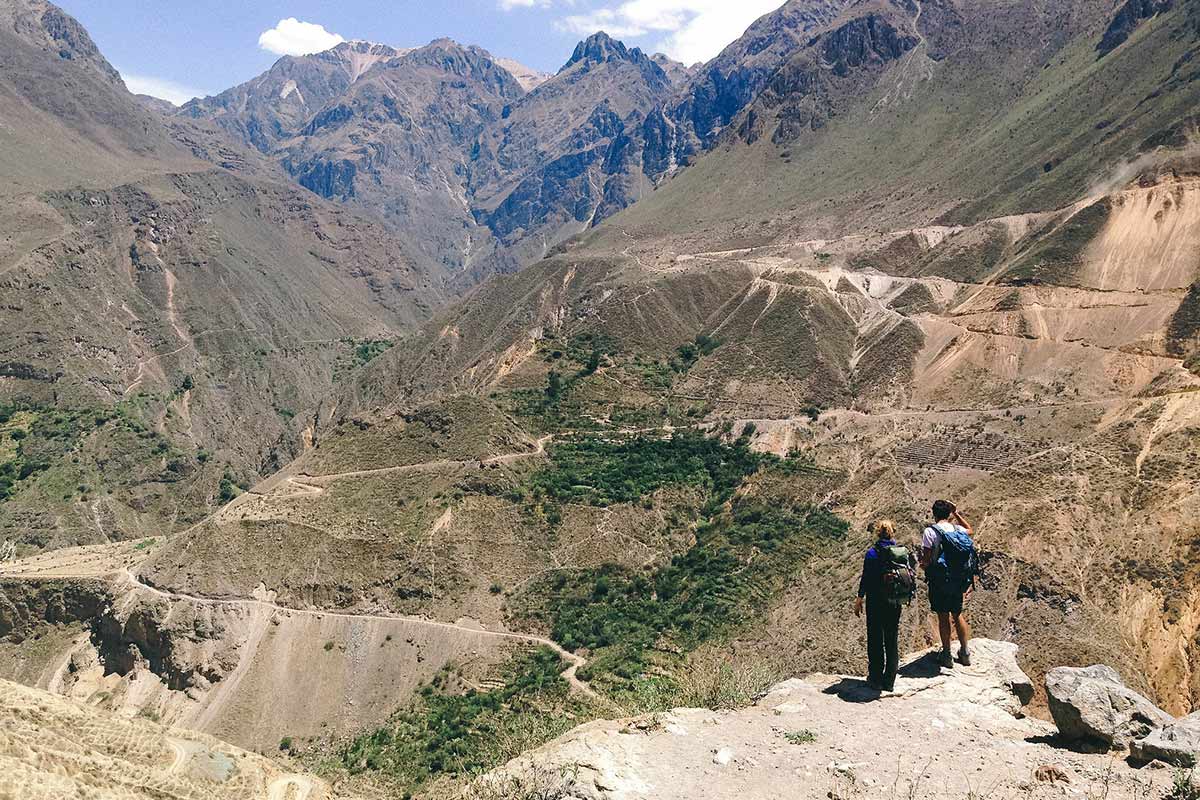
Make sure to enjoy the views along your Colca Canyon trek. Photo by free range jace/Flickr .
The ascent from San Juan de Chuccho out of the canyon to the San Miguel trailhead on the final day is exhausting – this is the second deepest canyon in the world after all! From there, continue about 15 minutes along level terrain back to Cabanaconde.
The town of Chivay is the main transit point for travelers in Colca Valley. Chivay is also easily accessible from Arequipa and a logical base for hikers. Trail options are varied and can suit any level, provided you’re already well acclimatized to the elevation.
If arriving late in the day, save your energy for a longer hike the following morning and enjoy a short 2-mi (3-km) walk to the town’s well-known La Calera hot springs. Entrance is 15 soles and you can bathe in one of the thermal pools ranging from warm to unbearably hot.
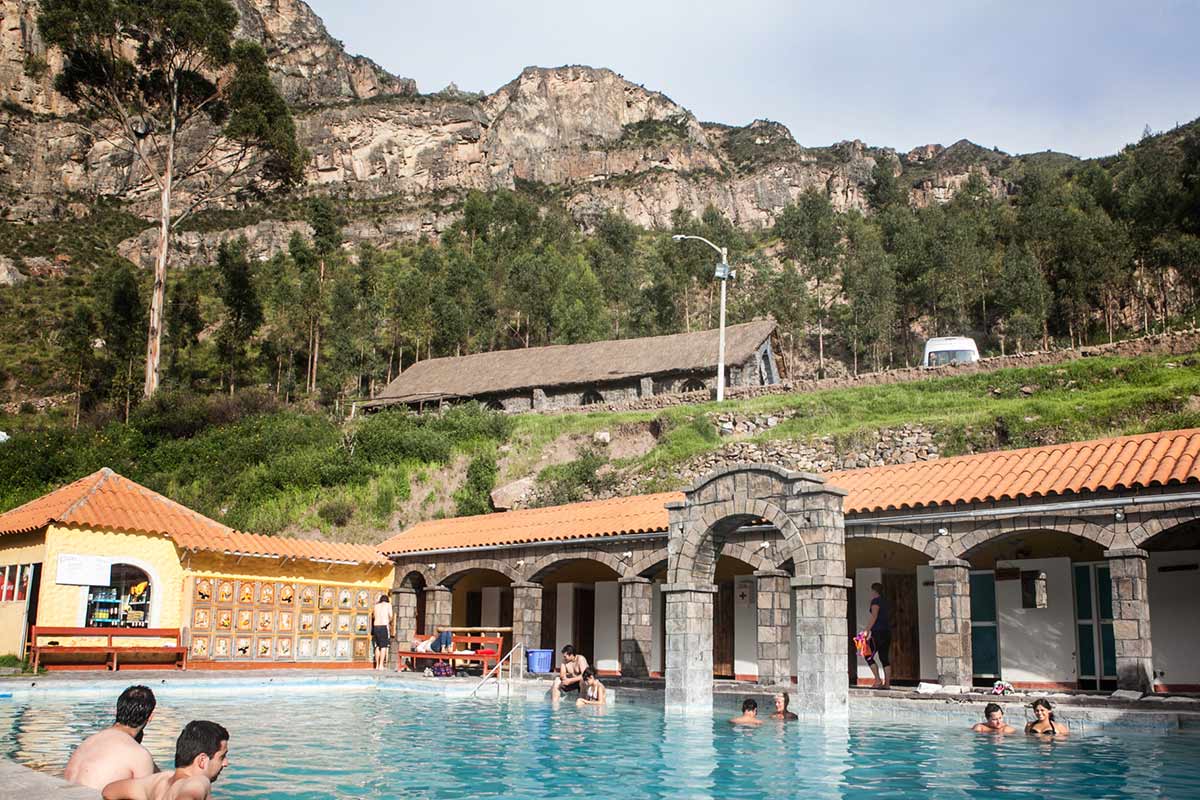
Rejuvenate with a dip in the thermal pools of La Calera. Original photo by Peru For Less.
Set up base in a hotel or hostel in Chivay offering basic services – hot water, cable TV, and breakfast. Alternatively, reserve a room at a top-ranked Colca Canyon hotel a short distance outside of town for a more memorable stay. Chivay has a healthy scattering of restaurants serving a range of food, from quick snacks to full hearty meals of local specialties, which will set you up well for a day or two of hard hiking.
Set out on a self-guided hike after breakfast and enjoy a 4.5 mi (7 km) walk from Chivay to the attractive village of Coporaque. Begin by strolling out of town along the road to La Calera, but cut left (along Av. Polonia) and cross Puente Inca (Inca Bridge) over the Colca River. Continue along the view-embellished road, passing fertile fields and views of distant snowy peaks to Coporaque. Here, you can visit some small pre-Inca ruins and find a pleasant river-side spot to stop and catch your breath.
Then, rather than retracing the same route back, follow the path downhill about 3 mi (5 km) to the neighboring village of Yanque, around 5 mi (8 km) from Chivay. You can either walk back from here or catch a bus or taxi back to town.
Uyo Uyo is an ancient village built by the Collagua group and later inhabited by the Incas. The remaining stone structures of the archaeological site are set against the natural beauty of the valley. From Yanque, cross the river and continue walking there along a country road. The hike to Uyo Uyo from Yanque Plaza is roughly 6 miles (10 km) roundtrip. Departing from Colca Lodge, it’s a shorter walk to Uyo Uyo and a nice way to spend a free morning or afternoon.
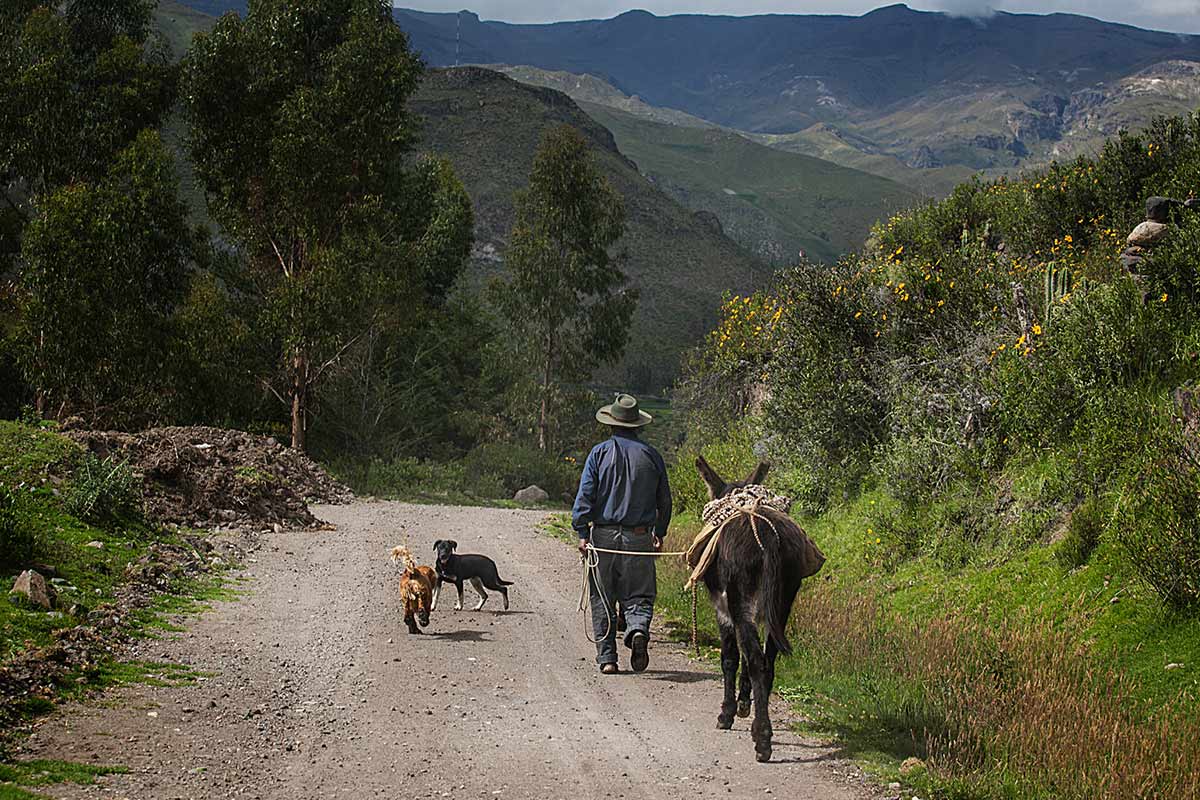
A local goes about life in Colca Canyon. Original photo by Peru For Less.
Traveler Tip: If you prefer, there are also guided short
walks around Colca, which are ideal for acclimatization.
Contact our experts
and ask what options are best suited for your custom itinerary.
The entire Colca region is on a high elevation plateau. For this reason, a few days of acclimatization before anything more energetic than a short walk is recommended.
Trekking destinations from Cabanaconde into Colca Canyon are lower in elevation, albeit far above sea level.
Cabanaconde – 10,760 ft (3,280 m)
Sangalle Oasis – 7,050 ft (2,150 m)
San Juan de Chuccho – 7,280 ft (2,220 m)
Llahuar – 6,630 ft (2,020 m)
Hikes in the Colca Valley are at slightly higher elevations:
Chivay – 11,800 ft (3,600 m)
Yanque – 11,155 ft (3,400 m)
Colca Canyon is one of the deepest canyons in the world, and the third is nearby Cotahuasi Canyon . The deepest point of Colca Canyon is roughly 13,648 ft (4,160 m) near the Huambo district in Peru’s province of Caylloma. The elevation of Arequipa, Peru is 7,661ft (2,335 m) and some trekkers may prefer to acclimatize there instead of going straight to Colca Canyon.
Your walking pace and the route you choose to walk through Colca Canyon are among the variables that contribute to the difficulty level. Climbing out of the canyon is steep and made more challenging with the high elevation, leaving even a fit person gasping for air at some point. Sections of the trail are also steep, so be sure to walk to the inside of the trail.
Remember to spend a few days adjusting to the Colca Canyon elevation before your trek and spread your outdoor adventure over a few days if you can. Drink plenty of water, start your days early to beat midday heat, and consider hiring a local to ride their donkey if you’re fatigued.
Similar to other high elevation destinations in Peru, Colca Canyon experiences a dry season during winter and a rainy season during the summer. Weather transitions are gradual between seasons.
The dry season is from May to November. Daytime temperatures are around 65°F (18°C) and get hotter in direct sunlight. At night, it dips to a crisp 25°F (4°C) without cloud coverage.
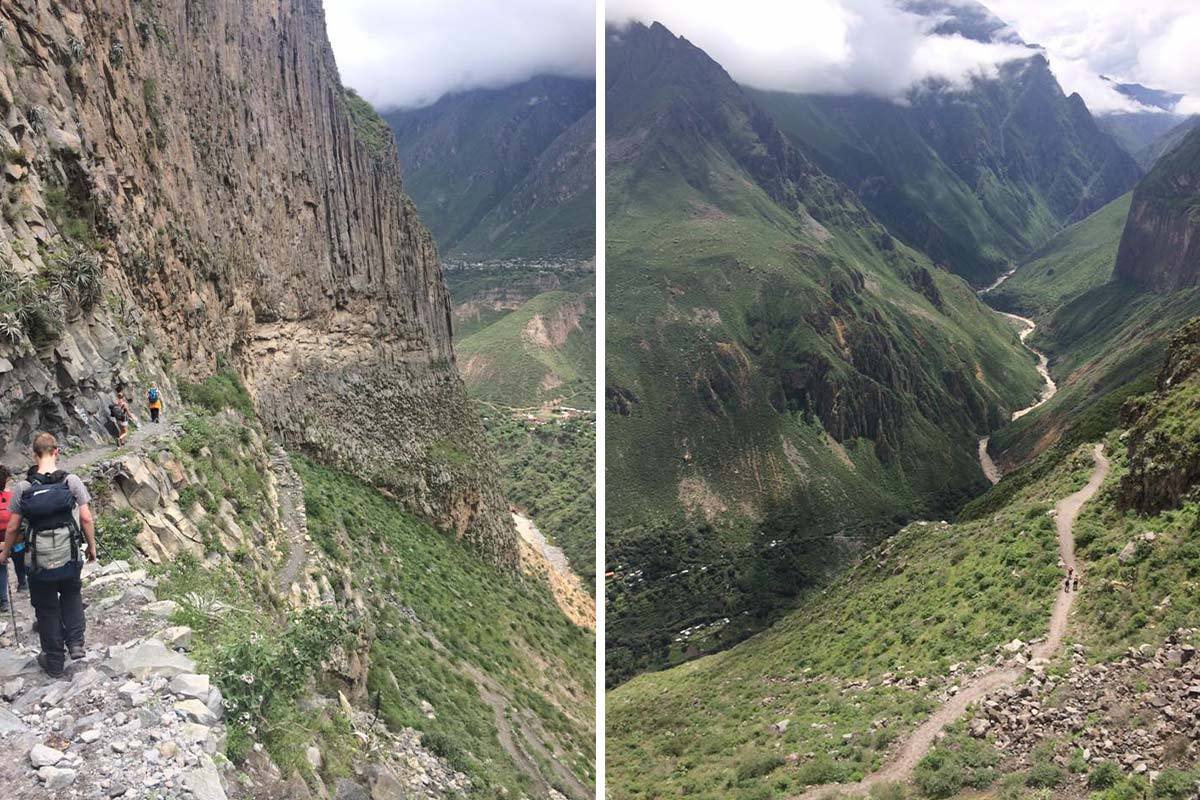
The rainy off-season brings beautiful greenery to Colca Canyon. Photos by Michelle Talsma/ Travel Advisor at Peru For Less.
The wet season is from January to March. The temperature is slightly cooler at around 60°F (16°C) during the day, but nights are typically warmer than dry season months with an average temperature of 45°F (7°C).
The dry season from May to November is the best time for a trek in Colca Canyon. With clear skies and plenty of sunshine, bringing protection from the sun (wide brim hat, glasses, and sunscreen with high SPF) is important at such a high elevation.
However, though the wet season brings muddy trails, the canyon scenery is beautifully green.
Villages within the canyon are great spots to fill up on water, snacks, and cooked meals. Sangalle, San Juan de Chuccho, Llahuar, and a few other villages host simple lodging that is a great alternative if you prefer not to camp. Additionally, there are numerous campsites to pitch your tent in and around canyon villages and natural attractions.
Colca Canyon is set within a vast natural park. The entrance costs 70 soles
(about $20) for a boleto turistico (tourist ticket).
You can plan a full day Colca Canyon tour from Arequipa, or extend your visit with an overnight at a hotel. Whichever option you choose, popular tour stops in the Colca Valley include La Calera hot springs near Chivay; a visit to the colonial town plaza of Yanque; and admiring the scenic terraced hillsides. Then, tours head west to narrower sections of Colca Canyon as far as Mirador Cruz del Condor to watch soaring Andean condors. From here, tour-goers can glimpse into the canyon depths but don’t venture into Colca Canyon.
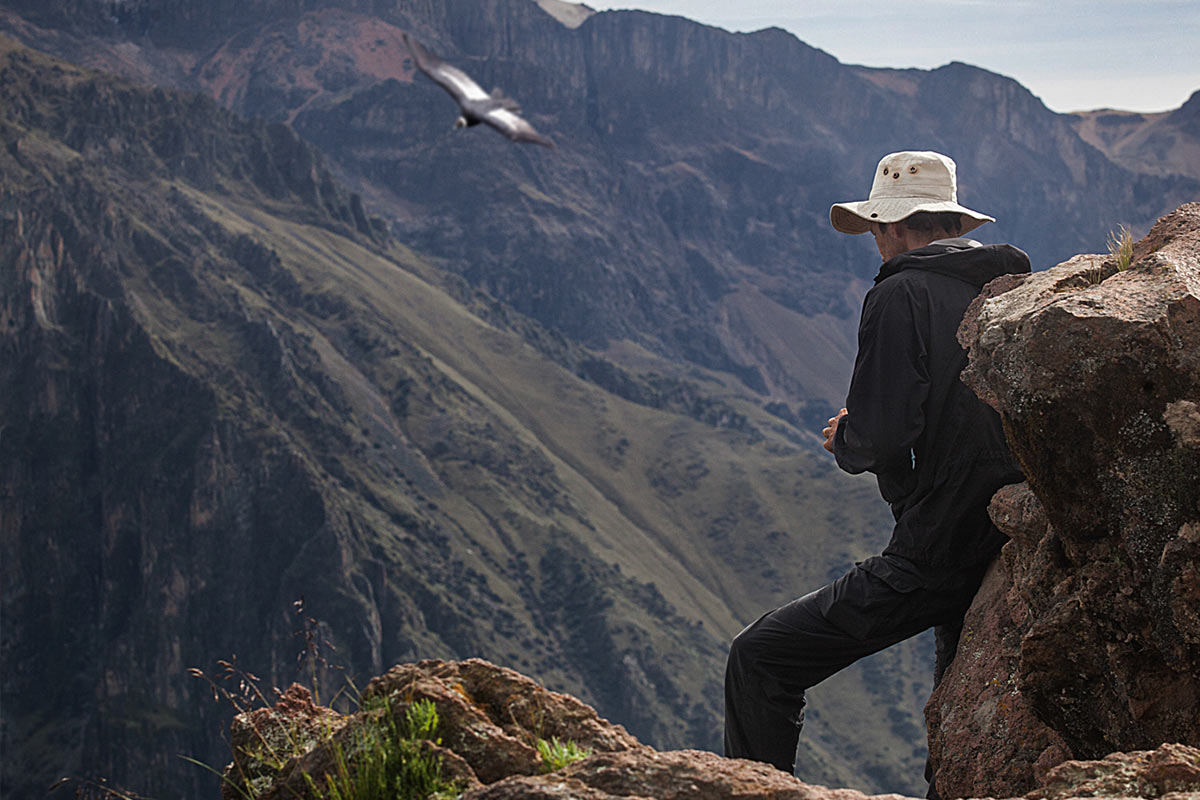
Andean condors are always a highlight of Colca Canyon, trekking or not. Original photo by Peru For Less.
A Colca Canyon trek, on the other hand, is a genuine way to experience the stunning beauty and small rural villages that have endured for centuries within the depths of the canyon. And with some luck, you may also spot Andean condors.
In Peru, it isn’t always convenient or possible to trek independently (such as on the Inca Trail or through the Amazon Rainforest ). Colca Canyon, however, is a wonderful place to venture on foot with the option to go with a guide or on your own. For more planning information, contact our team of experts to include a Colca Canyon trek and other regional attractions into your custom itinerary to Peru.
If you know you are going to Colca Canyon without a guide, then scroll down
and read our tips for independent trekkers in the next section.
A self-guided Colca Canyon hike is an adventure and a great option for saving money. The following are a few helpful tips to plan a fun and safe trek into Colca Canyon.
Plan your route. Trekking options from Cabanconde are plentiful and readily available. Purchase a map of the area and plan a Colca Canyon trekking adventure. Informal advice and information are also available from hotel staff and fellow hikers within the canyon. In general, don’t attempt a long trek alone unless you have the necessary equipment, skills, and prior experience. Check out our Packing Essentials section below.
Pick up outdoor gear in Arequipa. Trekkers that need equipment rentals, sportswear, maps, and any other instruction are best served in Arequipa, before heading into Colca Canyon.
Stay hydrated. The high elevation and strong sun in Colca Canyon make it important to stay hydrated. You can buy bottled water in Sangalle, San Juan de Chuccho, and other villages along the way. It’s also handy to have water purification to cut down on plastic usage.
Choose where to spend the night. There are numerous campsites. Outside of the villages and towns themselves, there are no services whatsoever so be sure to bring everything you’ll need. Additionally, there are simple lodges in some villages where you can spend the night instead if you prefer to travel lighter without overnight sleeping gear. It’s possible to book your stay online at a few canyon lodges.
Bring enough cash. There are not ATMs in Cabanaconde or any of the small villages on the walking circuits inside Colca Canyon. As such, plan and take out enough money in Arequipa before heading to Colca Canyon or in Chivay. Factor into your budget, sufficient Peruvian soles for transport, tourist ticket, food, water, lodging (if not camping), and other expenses.
Carry your boleto turistico in an easily-access spot in your backpack. Park officials may ask to see it at one of the various checkpoints in Colca Canyon.
TREKKING TOURS:
Here are items of outdoor clothing and equipment for your Colca Canyon trek:
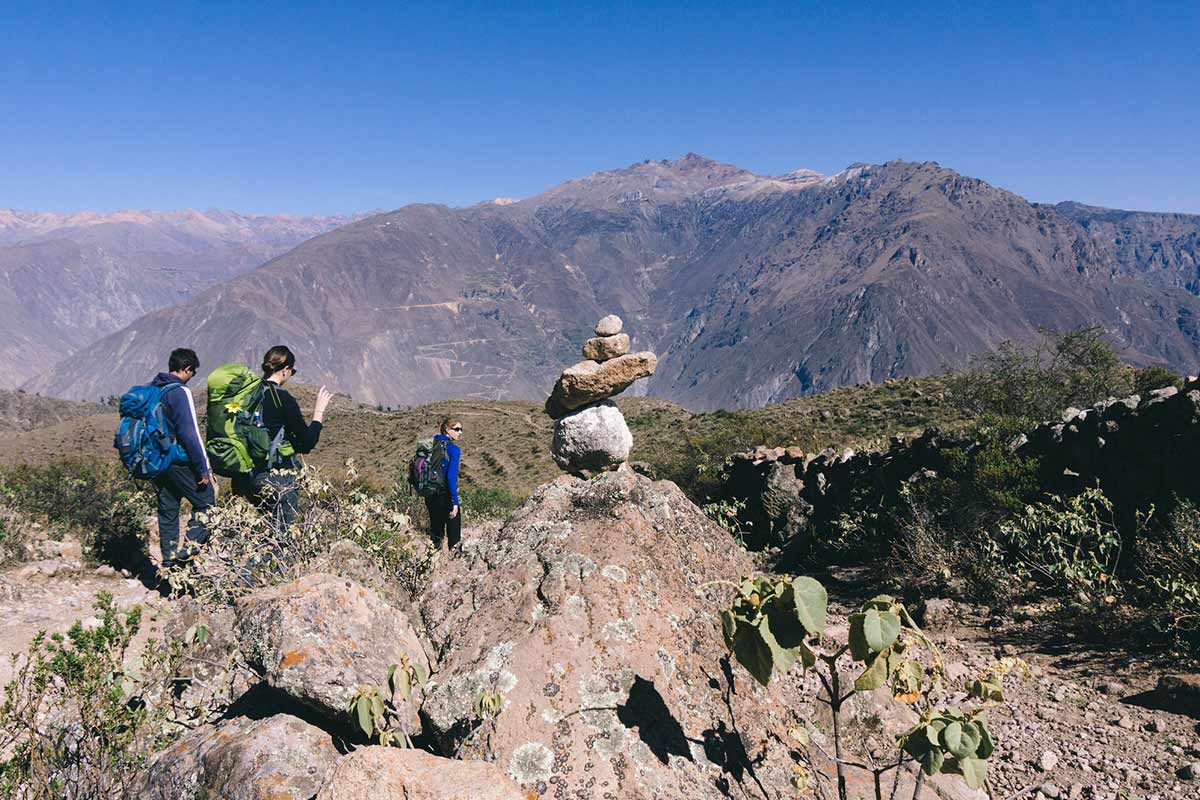
Set off on an exciting trekking adventure in Colca Canyon. Photo by free range jace/Flickr .
A guided or independent Colca Canyon trek is a great addition to your exploration of the world’s second deepest canyon. If you haven’t already read our Colca Canyon Travel Guide , it goes hand-in-hand with planning a trekking adventure and includes helpful information like how to get from Arequipa to Colca Canyon, so be sure to check it out.
Most Peru trekking experiences are focused around Cusco, Machu Picchu , and the Inca Trail but the country has a lot more to offer, and one of the finest and most rewarding alternatives is a trek in the Colca Canyon region near Arequipa. Contact our team and discuss the best way to fit a trek in Colca Canyon, Peru to your custom itinerary.
*Article was updated in July 2020.



Email: [email protected]
Sign up to receive our newsletter for great articles, stunning photos, and special deals.